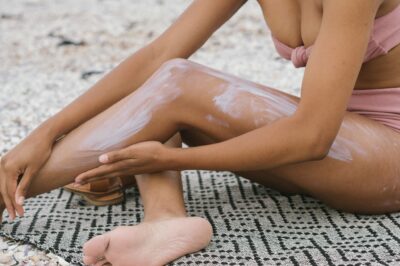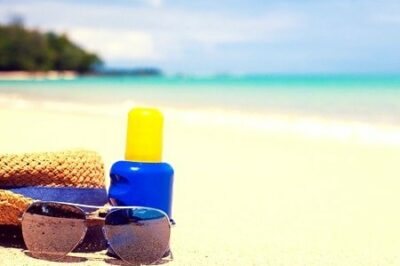We’re so excited to to have a sun protection product because we know we can trust what’s in it. Our Sun Love is full of good-for-you antioxidants and phytochemicals, it not only helps protect you from damaging UV rays, but also provides your skin with the nourishment and moisture it needs to resist the signs of premature aging.
For a long time, we didn’t put an SPF label on our Sun Love, a lot of people asked why, and we were honest about it…
The term “SPF”, by itself, doesn’t mean much, as far as real skin protection goes. Thirty, fifty, twenty-five…whatever the number, it doesn’t mean that one product is necessarily going to protect you more than another, even though it may seem that way.
We have SPF tested now that we’re an international brand (it’s SPF 20, by the way), but when we first released our Sun Love the cost to get it tested would have meant a steep increase in price for you, which we worked hard to avoid.
Here’s more about SPFs, what really protects your skin, and our philosophy on the whole thing. We think you’ll agree that using a product full of natural ingredients that nourish and protect your skin is far better than pulling a drug store brand off the shelf that’s full of potentially toxic chemicals — but that has an SPF of 60 — and expecting it to keep your skin young and healthy-looking while you bake in the sun.
What Does SPF Mean?
SPF stands for “sun protection factor,” but the term is rather confusing. We’re talking about protection only from UVB rays, which are thought to cause skin reddening and sunburn. Meanwhile, UVA rays, which are considered more dangerous when it comes to causing skin cancer, are left out of the equation.
An SPF number is a measure of the UVB radiation it takes to burn your skin, compared to what it takes to burn when the sunscreen is applied. If your skin typically starts to burn after about 10 minutes of sun exposure, for example, a product with an SPF of 30 would theoretically provide 30 times the protection. That would mean 300 minutes, or five hours.
Dig a little deeper, however, and you find that this number is extremely unreliable. One would think, based on the formula, that an SPF of 100 would protect you for twice as long as an SPF of 50, but according to the American Melanoma Foundation, that’s not true.
“Consumers need to be aware that SPF protection does not increase proportionally with an increased SPF number,” the foundation states on their website. “While an SPF of 2 will absorb 50% of ultraviolet radiation, an SPF of 15 absorbs 93% and an SPF of 34 absorbs 97%.”
Exactly why this is so gets a little complicated. Derek Thompson writing in The Atlantic explains it pretty well:
“Each minute wearing SPF 30 sunscreen lotion, you get a 1/30th, or 3.33%, of UV exposure that you would get without the lotion. Subtracting that 3.33 percentage points from 100, you’re protected from 97% of UVB rays with SPF 30 sunscreen.”
“If you want to impress friends at your local CVS, take the inverse of the number after SPF and subtract it from 100. That’s the percent protection you’re getting with the sunscreen lotion. It also explains why you see diminishing returns. SPF 10 is 90% protection. SPF 30 is 97%. SPF 80 sounds more than twice as strong. But with 99% sunblock, it provides almost identical protection.”
“As you get higher and higher, it’s not really a practical difference,” said Dr. David M. Pariser, the president of the American Academy of Dermatology.
To Get Full Protection, You Practically Have to Bathe In It
There’s also a significant difference between how sunscreen acts in the lab and how it acts in the real world. To get the protection of the SPF, you must apply it at a thickness of 2 milligrams per centimeter of skin. A 2011 study published in the scientific journal BMJ noted that in reality, people using sunscreens typically apply much less than the amount used in studies, and “get no more than half, at best, of the protection indicated by the labeled SPF.”
They go on to state that applying sunscreen adequately over a large part of the body is “almost impossible, as with this amount, the sunscreen runs off the skin and it is difficult to achieve a cosmetically pleasing application.”
Using these amounts would also be costly. Covering the whole body at the suggested level would require 35 mL of sunscreen. If you then reapply every two hours, as suggested, you’d use up a standard 200 mL bottle every 2-3 days.
Where Are They Getting the Number?
The FDA requires manufacturers to test their products on skin to determine the SPF level. But even numbers achieved through the proper process are often misleading. People with different complexions burn at different rates—but studies usually involve only one type of skin. Experimenters use more formula than average people do, as we mentioned. And don’t forget—the number tells you nothing about how the product protects against dangerous UVA rays.
FDA Crackdown on Sunscreen
A few years ago, sunscreen manufacturers engaged in a numbers war. One would come out with a formula labeled SPF 70, and soon after, another would release a formula with an SPF of 85, and soon it was up to 100, and higher.
The FDA decided enough was enough. In 2011, they issued new rules to sunscreen manufacturers, telling them what they could and couldn’t say on their product labels. Some of the changes, which became effective in June 2012, included:
- Products must pass a standardized laboratory test to be labeled as providing “broad spectrum” protection, which means protecting against both UVA and UVB rays. This is new—prior to this, in vitro testing was not required.
- Products that do not provide broad spectrum protection, or that have SPF values from only 2 to 14, must have a warning that they do not protect against skin cancer or premature aging—only sunburn.
- Products can no longer be labeled as “waterproof” as there is no such thing. They can only say “water resistant,” and must tell consumers how long the product will protect their skin when they’re swimming or sweating.
- Products that have SPF values higher than 50 may no longer use high numbers—instead, they can only say: SPF 50+. “FDA does not have adequate data demonstrating that products with SPF values higher than 50 provide additional protection compared to products with SPF values of 50,” the agency stated.
Why We Use Zinc Oxide
We talked about zinc oxide at length in another post, but in case you missed it, we wanted to explain our choice of zinc oxide in this formula.
Studies have shown that a number of chemical sunscreens, such as PABA, cinnamates, oxybenzone, and more can react with the sun’s rays to create damaging free radicals, which may actually increase the risk of skin cancer. Chemical sunscreens have also been linked with hormone disruption. Research has found that they can act like estrogen in the body, throwing natural hormones off balance. In a study of six common sunscreen chemicals, five acted like estrogen, causing an increase in human breast cancer cells.
Another concern with these sunscreens is that they have the potential to penetrate deeply into skin, getting inside the body. A 1999 study, for instance, found that all sunscreen agents tested penetrated into the skin, with benzophenone-3 (oxybenzone) passing through in significant amounts. In 2008, the Centers for Disease Control and Prevention (CDC) reported that nearly all Americans were contaminated with oxybenzone, which has been linked with hormone disruption and allergies.
To get away from these risks, most dermatologists and other skin care experts recommend using so-called “physical” sunscreens like titanium dioxide and zinc oxide. They both reflect and neutralize UV rays, and provide broad-spectrum protection. Titanium dioxide is a heavy metal, however, and is potentially toxic if in nanoparticle form and inhaled in large amounts.
Zinc is an essential mineral that we actually need in our bodies for optimal function, and is the only active sunscreen ingredient approved by the FDA for infants under six months.
Evidence Behind Zinc’s Effectiveness
A number of studies have demonstrated the superiority of zinc over other types of sunscreens. Here’s a small sample:
- 1997: Researchers tested zinc oxide and found it offered broad-spectrum UV protection, and was “photostable,” meaning it didn’t alter in dangerous ways when exposed to UV rays.
- 2000: Researchers compare zinc oxide with titanium dioxide for their abilities to weaken UVA radiation. They found that zinc oxide provided superior protection against long-wave, damaging UVA rays.
- 2001: Researchers compared zinc oxide to titanium dioxide and found that zinc demonstrated “superior protection” compared to titanium dioxide against long-wave UVA radiation, and was less “white” at a given concentration in the formula.
- 2002: In Sunscreens by the Cosmetic Science and Technology Series, researchers report that while titanium dioxide is an excellent UVB blocker, zinc oxide offers broader protection as a UVA and UVB block.
We use 18 percent zinc oxide in our formulas, which you can see from this chart, provides the protection deemed necessary by dermatologists. We know that it helps protect you from damaging sun rays, both UVA and UVB. But we haven’t put a number on it, for all the reasons shown here.
A quick summary:
- SPF numbers are misleading and provide a false sense of security.
- If you rely on SPF numbers, you’re likely to suffer sun damage and premature aging.
- Testing to determine SPF is expensive and would require us to pass the cost on to our customers.
- SPF tells you nothing about whether the product protects from dangerous UVA rays, or whether it will help increase your resistance to skin cancer.
Our Philosophy
We prefer to be completely honest with you about what’s in our Sun Love product, including what the SPF is, so that you can look at the facts and make your own decision.
We’re excited to provide you with a product that contains the safest sun protection available (zinc oxide), along with many natural plant ingredients that are known to help protect your skin from the sun, and that also provide antioxidant protection to help shield you from the damage that can occur through exposure to UV radiation.
You can apply this product anywhere on your body—even on your children—every day, and enjoy the peace of mind that comes with using a completely safe product that not only protects you, but that is nourishing and hydrating to your skin.
We hope you’ll love Sun Love as much as we do, and we also hope that even when using it, you’ll continue to be smart about sun exposure!








I like your sun love product but i have a few questions. Mine seems to separate quickly and shaking it vigorously doesn’t always get it mixed so an oil blob comes out. Is this normal? it looks quite greasy on but thankfully not white! how would you recommend I solve this? How long is the sunscreen effective? I want to have my friends love this but all that have tried don’t like the oiliness of it. Did i receive a bad one or maybe i’m doing something wrong? I LOVE all the other products so far and I hope with help to love this one too!
Hi Nathalie!
Our Sun Love is a rich & creamy product—because the weight of the beeswax, zinc oxide, and cocoa seed butter is heavier than the other oils in the product, it separates easily. If you run the tube under some warm water for a couple minutes it can help the product mix together more easily when you shake it 🙂
We recommend reapplying every hour when exposed to direct sunlight!
If you decide that Sun Love is not a good fit, please let us know so we can help you arrange a return or exchange! You can email us at ask@annmariegianni.com to set that up if needed 🙂
How is it legal that you’re advertising sun protection without testing your product for an spf rating? This stuff sounds like chemophobic nonsense.
Is Sun Love safe to use under/around the eyes?
Yes, absolutely 🙂
I like this sunscreen. It is moisturizing without being greasy. It has a skin color tint to it, so you don’t look white afterward, or leave white streaks.
I especially liked this touch!
It is expensive, but I only use it on my face. I live in Florida & Panama, so it is important to wear sunscreen. I tried another “natural” product, two days, but I felt & looked like I was dripping in oil. Not this one! Goes on smoothly, and absorbs well.
This SPF discussion is quite interesting. Wonder if zinc oxide in,your Sunlove shows up ghostly white ? A drawback for me, even,though I am a senior living in sunny Florida.
Sure would,love a sample to try.
Hi Judith! We add iron oxide to this formula to give it a subtle tint. Therefore it does not show up white on the face at all. You can get a sample here –> https://www.annmariegianni.com/sunlove/
I would also be interested in an un-tinted version. I live in Houston and I sweat heavily. I know my face would be constantly streaked and that I would have to worry about that! (It’s the reason I don’t wear any base makeup at all from November to March.) It would be so much easier for me if the product just didn’t have a tint.
Hello,
I purchased a sample of the Sun Love product and absolutely love it. I am worried however, because I have skin cancer especially on my face and really need sun protection. Without knowing an SPF I’m not sure if I am getting enough coverage. What do you think about using this product on people with skin cancer?
Thank you,
Lisa
Hi Lisa,
I’m so sorry that you’re dealing with skin cancer, I’m glad that you are looking for natural ways to protect your skin! We cannot give advice about skin care for skin cancer, but what I can tell you is that there is 18% zinc oxide in Sun Love, if you want to compare it to similar products.
Amazing information! Yet another misleading load of garbage from companies who are not about the quality of the product and representation or truth, but just about competion in marketing and the almighty dollar!
Thank you so much for putting this information out there! I think your goals and efforts are truly the most integral I have ever seen! May your company be blessed and full of success as your reward for the honesty and caring to all of us out here trying to weed thru the marketing hype!
I have not received my testing kit yet, but when I do I will definitely come back and give you feedback!
If I want more tint can I mix Sun Love with your mineral foundation?
Hi Stephanie,
Yes! Sun Love mixes beautifully with Minerals by Annmarie Multi-Purpose Foundation.
It’s true that SPF doesn’t include protection against UVA but it still should be an important factor in deciding which sunscreen to use. A broad spectrum sunscreen with an SPF that has been tested is, in my opinion, far superior to one that simply relies on past research of the ingredients to determine if the sun protection is adequate. An SPF of 30 is generally recommended to prevent sunburn and damaging effects of the sun but since nobody knows how much protection Sunlove really gives, why buy it? There are plenty of other companies selling tested natural sunscreens with equally good ingredients for a similar or cheaper price.
Would you ever consider making Sun Love with no tint In the future? I usually wear a baseball cap (for golf) and don’t like to get staining in the band under the bill. That’s why I haven’t ordered Sun Love. I’ve used a tinted sunscreen in the past but had to use a non-tinted sunscreen on my forehead.
Thanks,
Hi Judy! Thanks for the feedback. We don’t have any plans to make an untinted Sun Love yet. I use this one from Badger Balm: http://www.badgerbalm.com/p-565-spf-20-rose-face-sunscreen.aspx
Hi! Just got a sample in the mail – excited to try!! Was wondering – is the zinc oxide micronized or nano?? Thanks!!
Hi Susane,
The Zinc is micronized. 🙂 Hope you love it!
Is that the same as “non-nano”?
Hi Michelle,
We use non-nano zinc oxide in Sun Love.
I meant I believed 100%. It miss spelled.
I absolutely loved the information and most of all, to find a safe suncream, I knew that all sunscreen were bad for you, that is why I never use for me or my children, but now I am going to try yours, just by redding the information I beluevd 100%. That is awesome. Thank you.
I absolutely love Sun Love sun protection. It doesn’t feel like you’re putting on sun block at all, instead it has a lovely chocolaty aroma and creamy texture, goes on like a moisturizing light foundation, adding a bit of color and coverage. Unlike other sun screens you can FEEL it’s not chemical. GREAT! ***
Ditto on above comment. as a latina , med toned skin woman I have NEVER used sunscreen… having said that now that I’m 56 and feeling better than ever about my health and quality of my skin, using Annemarie natural skin products, I just fell good knowing that I’m not adding any more chemicals to my system. AND getting some UV protection. I strongly believe in living a CLEAN life from the inside out and Sun Love fits the bill! great product!
ps. Annmarie , as a company has the most awesome customer service!!
I got a sampe of sun love and tried it. I love this product. I suffer from melasma so I’m always needing sun screen. But most are greasy n make my skin shiny. Sun Love goes on smooth n absorbs quickly. I can wear makeup over it and not have that greasy look. Above all I love the fact that it’s not damaging to my skin. After reading the article on sun screen I wonder how much to put on.
Hi Susana!
Happy to hear you are enjoying the Sun Love 🙂 It’s an awesome product!
We recommend using about a dime size amount to cover the face and neck. If you feel that you need more, you can always apply a little more! Re-apply every couple of hours, or every hour if you are in the direct sunshine.
I’m printing out this information and sharing it with my dermatologist. Very informative article. Thank you for this information..I’m going to try the free sample.
Thanks Barbara! 🙂
Hi, I appreciate/understand *why* you are not giving your product an SPF rating as explained above, but if you had to give it a number, what would you give? I only ask because we are going on holiday to France over the summer and I would like to use it on my children as well as me and husband. Do you think it will provide sufficient protection for my kids?
Also, what would the UVB rating be? I usually buy a product with full 5 star UVB protection, but obviously I’d like to avoid the chemical laden products.
Many thanks
Hi Yvonna-
We cannot give an actual “Rating” for our Sun Protection. However, we can say that Zinc Oxide (which is what we include at 18%) is full spectrum protection. We believe this sun protection is safe for kids, but we do encourage it to be reapplied if they are actively outside or swimming because it is not waterproof. Hope this helps!